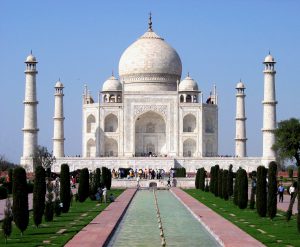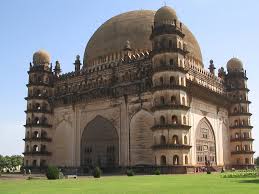Indo-Islamic Architecture – Part II (UPSC Notes):-
Aspirants would find this article very helpful while preparing for the UPSC 2021
Architecture in Mandu, Madhya Pradesh
- Mandu is located 60 miles from Indore in Madhya Pradesh.
- The city is at an elevation of 2000 feet overlooking the Malwa Plateau to the north and the Narmada Valley to the south.
- It was constantly occupied by the Parmara Rajputs, Afghans and Mughals because of its natural defence.
- It was the capital of the Ghauri Dynasty (1401 – 1561) founded by Hoshang Shah.
- Great example of the medieval provincial style of art and architecture.
- It has many official and residential pleasure palaces, mosques, artificial reservoirs, pavilions, baolis, embattlements, etc.
- Most structures have arched pavilions, and are light and airy, so that they do not retain heat.
- Local stone and marble were used.
- Great example of architectural adaptation to the environment.
- Royal Enclave: Set of romantic buildings built around 2 artificial lakes.
- Hindola Mahal
- Audience hall of the Sultan
- Resembles a railway viaduct bridge with its large buttresses to support the walls
- Batter was used to give the impression of swinging (hindola) walls
- Jahaaz Mahal
- Two-storeyed ship-palace
- Built between 2 reservoirs
- Has open pavilions, balconies and a terrace
- Built by Sultan Ghiyasuddin Khilji possibly for using as his harem
- Had a terrace swimming pool
- Rani Rupamati’s double pavilion
- Baz Bahadur’s palace
- Asharfi Mahal – a madrassa
- Hoshang Shah’s tomb
- Example of the robustness of Afghan structures
- Majestic structure with a beautiful dome
- Has marble jail work, courts, porticos and towers
- Also has lattice work, toranas and carved brackets
- Jama Masjid
- Has a grand gateway and a squat dome
- Building is faced with red sandstone
- Mihrab has a lotus bud fringe
- Qibla Liwan is supported on carved brackets
Aspiring Civil Services candidates can go through Some Aspects of Indo-Islamic Architecture – Part I on the linked page.
Taj Mahal

- Built by Mughal Emperor Shah Jahan in memory of his wife Mumtaz Mahal.
- Built from 1632 and took almost 20 years to complete.
- Built by 20000 specialised workers.
- It is a mausoleum.
- It has a simple plan and elevation.
- One of the most famous architectural marvels of India worldwide.
- The structure is breathtakingly symmetrical.
- Made of white marble brought from the Makrana Mines, Rajasthan.
- It is a UNESCO World Heritage Site.
- Its monumental gateway is made of red sandstone.
- The tomb is set in a Chahar Bagh, criss-crossed with paths and water courses, along with pools and fountains.
- The tomb is on a floor terrace. On the four sides of the terrace, there are four tall minarets which are 132 feet high each.
- The main building has a drum and a dome with four cupolas.
- Towards the west of the structure is a mosque made of red sandstone.
- Towards the east is a similar structure to maintain the balance.
- Interior arrangements of the mausoleum: crypt below, vaulted, octagonal tomb chamber above; there is a room at each angle which are all connected via corridors.
- Light comes into every corner of the building through perforated and carved jalis that are set in the arched recesses of the interior.
- A double dome helps create a void that makes the ceiling as high as the façade.
- Four types of embellishments:
- Stone carvings in high and low relief on the walls
- Marble carving onto the jalis and volutes
- Creation of arabesques with pietra dura on walls and tombstones, and geometric designs with tessellation
- Calligraphy – used in the inlay of jasper in white marble to write verses from the Quran
Candidates can check out a few articles linked below to prepare for upcoming civil services examination-
| Temple Architecture and Sculpture – Part II |
| Indian Bronze Sculpture |
| Temple Architecture and Sculpture – Part I |
| Major Indian Temple Architecture Style |
| Dravidian Architecture in India |
| Buddhist and Jain Architecture in India |
Gol Gumbad

- Location: Bijapur, Karnataka.
- Mausoleum of Muhammad Adil Shah (1626–1656), Adil Shahi Dynasty of Bijapur (1489–1686).
- Built by Muhammad Adil Shah himself.
- Tomb is a complex consisting of a gateway, a mosque, a Naqqar Khana, and a sarai within a big-walled garden.
- The building is a huge square one with a circular drum. Above the drum is a majestic dome.
- Material: dark gray basalt with decorated plasterwork.
- The whole building is over 200 feet high.
- The tomb has a square chamber.
- The dome is the largest in the world with a diameter of 125 feet and an uninterrupted floor space of 18337 square feet.
- Pendentives helped build the hemispherical masonry dome over the square base.
- The building has an impressive acoustic system with a whispering gallery where sounds get magnified and echoed multiple times.
- At the four corners of the building there are seven-storeyed octagonal spires or minarets.
- This structure is a mix of many styles including local, Timurid and Persian styles.
